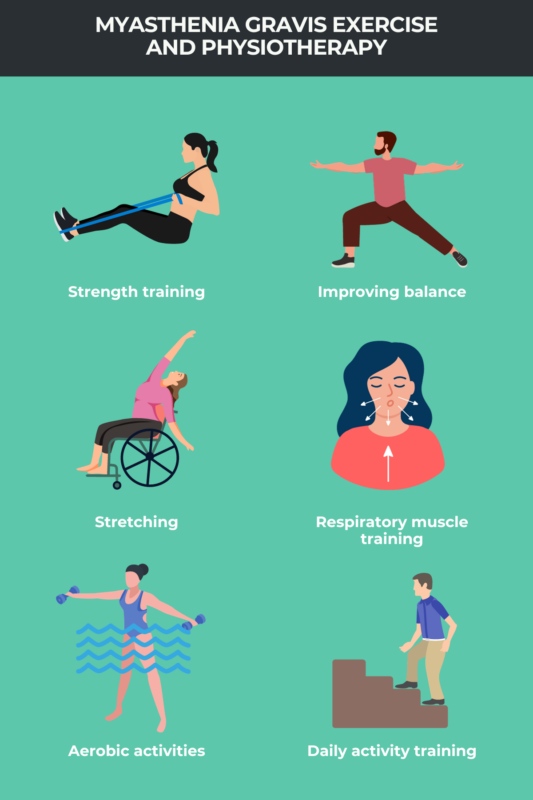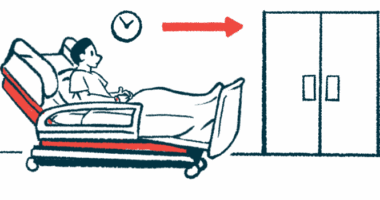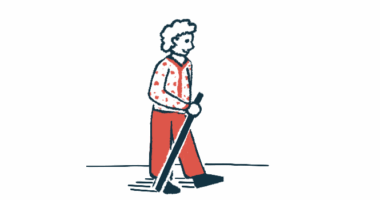
Exercise and physiotherapy for people with myasthenia gravis
A well-planned and monitored exercise program can make a difference in the lives of people living with myasthenia gravis (MG). Regular exercise can help to improve muscle strength and balance, alleviate fatigue, and boost overall quality of life, while physiotherapy can help people manage their MG symptoms.
MG is an autoimmune condition that causes muscle weakness and fatigue. It happens when there is damage at the neuromuscular junction, which is where nerve and muscle cells communicate. Diagnosing MG may involve a series of blood, nerve, muscle, and imaging tests.
In early disease stages, MG usually affects a restricted group of muscles, such as those controlling eyelid movement, which may lead to symptoms including drooping eyelids (ptosis) or double vision (diplopia). During MG progression, other muscle groups, such as those involved in limb movement or breathing, also may be affected.
People living with MG may find that after exercising their muscles are unusually weak and tired.
A carefully designed exercise program can help people with MG maintain their physical capabilities and increase energy, allowing them to carry out daily activities with greater ease.
Does exercise help people with MG?
Karen Ricciuto, a neuromuscular physiotherapist in Port Perry, Ontario, says exercise can help in dealing with an illness like MG by making people more physically and emotionally resilient.
An exercise routine should be started in consultation with healthcare professionals such as a physiotherapist and a neurologist to ensure the exercises are safe and appropriate for a person with MG. Additionally, they will consider the person’s current level of fitness, the severity of their MG symptoms, and any individual limitations and goals.
Some of the potential benefits of exercise include:
- improved muscle strength
- increased stamina and endurance
- better ability to breathe
- better cardiovascular health
- better mental health
- better sleep
- weight management
- better ability to do daily tasks, such as walking up stairs or doing laundry
- helping prevent falls.
Other MG treatments may include medications, avoiding triggers, plasmapheresis, and thymectomy. It’s also important to eat a healthy diet. If there are bulbar symptoms, which can cause difficulty swallowing (dysphagia), this may require food to be cut into smaller pieces or pureed.
How to exercise safely
Before starting to exercise, speak with a physical therapist or neurologist familiar with MG about the best way to do it safely, which might include the proper way to do low-impact activities that are generally gentle on the muscles and joints, such as walking, swimming, or stationary cycling.
At first, a physical therapist or neurologist may supervise these activities and eventually offer guidance for exercising at home or in other settings. They can help come up with achievable goals and adapt the exercise routine as MG symptoms fluctuate.
“MG patients who have respiratory muscle weakness should be exercising in a supervised setting to ensure adequate breathing,” Ricciuto says. She adds that because people with MG may have an altered sense of balance, she always checks that they have the right supports and footwear and that surfaces are level, to avoid falls.
She also suggests people with MG schedule rest breaks. For example, if going for a walk, plan a stop at a park bench at specific intervals. Another tip is to break up an exercise program into smaller chunks during the day, alternating with periods of rest.
“Follow a plan, but listen to your body,” she advises.


Living with MG
Navigating Mental Health with Myasthenia Gravis
Other tips for safe exercise include the following:
- Start with a warmup and end with a cooldown.
- Stay well hydrated.
- Monitor energy levels and stop when feeling over fatigued.
- Coordinate exercise around medications as some MG medications may affect muscle strength.
- Find a partner who can help support safe exercise.
- Use adaptive equipment as recommended by a healthcare professional.
Finally, Ricciuto says people with MG should avoid high-intensity interval training, which has been shown to increase symptoms of muscle weakness.
Strength training
Strength training involves resistance exercises to help build and maintain muscle strength. This is important for people with MG because muscle weakness is a common symptom.
Strength training can be targeted. For example, it can help with balance problems and MG walking problems. Strengthening the muscles around joints can provide better stability. Ricciuto works with her patients on exercises that target large muscle groups, such as the hips and shoulders.
She says moderate-intensity resistance training is less likely to fatigue a person with MG.
Ricciuto also creates a plan that includes functional exercises that translate into activities of daily living, such as doing step-ups, squats, and overhead reaching.
“These mimic daily function and aid in making daily tasks easier,” she says, adding people should use an upright lower back and engage their core muscles when lifting.
A person with MG should always make sure they have a good stance for stability when doing activities and exercises. A personal trainer or fitness instructor can show people how to do exercises with the correct form, minimizing the risk of injury and increasing the effectiveness of each exercise.
Strength training also can have a positive effect on bone density. This is key because people with MG may be at risk for bone-related issues due to reduced physical activity and the use of corticosteroid medications.
It also can have a positive effect on respiratory muscle strength and has been shown to help manage fatigue-related weakness and respiratory failure, particularly in moderate cases that interfere with activities of daily life, such as showering, doing laundry, or transferring from a wheelchair to bed.
Stretching exercises
Stretching exercises can improve flexibility, reduce discomfort from muscle cramps, and increase mobility. Stretching also can improve balance and coordination, and because it usually is a relaxing activity, it may reduce stress and foster a sense of well-being.
Stretching is an integral part of a proper warmup before exercise and cooling down afterward. It helps prepare the muscles for activity and prevent post-exercise muscle soreness.
Stretching should be done gently; always stop if it causes pain or strain.
Suitable stretches for a person with MG include:
- neck stretches, tilting the head forward and back, and from side to side
- shoulder rolls, rolling the shoulders forward and back
- back stretches, sitting in a chair, slowly twisting the upper body to one side, while holding the backrest for support; repeat on the other side
- hip flexor stretch, which is sitting in a chair, extend one leg straight out and bend the other knee; gently lean forward to stretch the hip flexor.
Balance and coordination exercises
Balance exercises can improve muscle control and coordination, helping people with MG maintain better stability while standing and walking.
It also can help reduce the risk of falls. By practicing balance exercises, a person with MG might be able to prevent a fall after a stumble or a loss of balance.
Balance and coordination exercises might include:
- weight shifting, which involves stand with feet hip-width apart and slowly shift weight from one foot to another
- sit-to-stand, rising from a seated position in a sturdy chair without using the arms for support
- one leg balancing, which is balancing on one leg for as long as possible
- stair climbing, which is gripping a handrail while climbing stairs to improve leg strength and coordination.
Aerobic exercise
Aerobic exercises for MG can include low-impact activities that minimize muscle strain and fatigue.
According to Ricciuto, general aerobic exercise, such as walking or biking, can improve respiratory capacity and respiratory muscle strength.
Other low-impact exercises include:
- swimming and water aerobics, which provide resistance without placing too much stress on the muscles
- stationary cycling, as using a stationary bicycle allows for a controlled, low-impact aerobic activity
- seated aerobics, where seated marching or chair-based routines allows exercise while sitting down
- resistance band workouts, which help promote cardiovascular fitness without excessive muscle strain.
Benefits of physiotherapy for people with MG
MG physiotherapy, also known as physical therapy for MG, can help people manage their symptoms and improve functionality.
Physical therapists can design tailored exercise programs, help people with MG build and maintain muscle strength, reduce the risk of falls through balance exercises, and teach breathing techniques to improve respiratory muscle strength and function.
A physical therapist also can help a person with MG learn to do everyday activities including standing, walking, dressing, and grooming, and can provide guidance on using assistive devices, such as mobility aids and adaptive equipment.
“Regular follow-up in the clinic (is done) as needed to progress exercises, adjust as needed, and monitor any strength and flexibility changes,” Ricciuto says.
She adds that she offers exercise handouts and encourages using exercise apps that have how-to videos and a way to track the completion of an exercise.
Myasthenia Gravis News is strictly a news and information website about the disease. It does not provide medical advice, diagnosis, or treatment. This content is not intended to be a substitute for professional medical advice, diagnosis, or treatment. Always seek the advice of your physician or other qualified health provider with any questions you may have regarding a medical condition. Never disregard professional medical advice or delay in seeking it because of something you have read on this website.
Recent Posts
- Doctors say MG doesn’t cause pain, but my body suggests otherwise
- Taking Vyvgart before thymectomy may help improve surgery outcomes
- Finding ways to reduce suffering, even while living with chronic pain
- Guest Voice: What living between labels taught me about MG
- MG-specific treatments needed for older patients, researchers say
 Fact-checked by
Fact-checked by 






